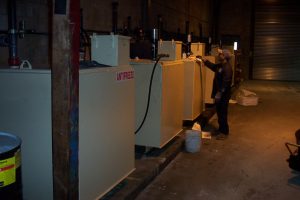 Hazards caused by above ground storage tanks and how to avoid them
Hazards caused by above ground storage tanks and how to avoid them
Above ground storage tanks (AST) can be a real plus. They’re easier and less expensive to install, and they’re certainly easier to monitor since you can see them. Advances in above ground storage tank containment technologies are one reason that ASTs are becoming more widely accepted.
Nonetheless, not all municipalities allow them and local regulations can differ based on whether you plan to sell the product being stored or keep it for private use only. Regardless, by their very nature ASTs can create significant workplace dangers. That’s why above ground storage tank containment systems and procedures are critically important.
Worksite dangers can have a significant impact on your employees, of course. But the hazards associated with above ground storage tanks can also potentially harm the natural environment–air, soil and groundwater–contaminating drinking water for humans and rendering streams and rivers toxic for wildlife.
Here are five workplace dangers that can be caused by above ground storage tank containment.
1. Physical accidents.
Containment includes protection. Without it, vandals can damage tanks or vandals can run into them. Thoughtless behaviors such as smoking around tanks can cause explosions or fires.
2. Tank cleaning.
Regular inspection and cleaning procedures put people in close physical proximity to above ground storage tank containment systems, which could very well hold something more dangerous than a little built-up rainwater.
3. Spills, leaks and releases.
This is the big one, of course. Hazardous substances can escape into the air or soil as the result of an accident, sloppy tank cleaning procedures or corrosion or breakage that can occur over time with tanks, piping or their connections. Breathing or direct contact with these vapors or liquids can cause a wide range of problems.
Some may be deemed “incidental” — non-emergency spills, etc. that are relatively easy to clean up and don’t pose a threat to health or safety of people or the environment. But a major spill or release constitutes a full-scale emergency requiring immediate response and remediation steps.
4. Improper personal protections.
The rules are clear on what kind of personal protective equipment is required for employees working with petroleum products and hazardous substances such as gasoline or diesel fuel, fuel oils and other liquid chemicals. Failure to provide – and ensure use of — gear from face masks and respirators to safety glasses, gloves, even entire body clothing can exacerbate all other workplace dangers, with potentially disastrous health and safety repercussions.
Workers in confined spaces or performing “hot” work such as welding near tanks especially need to observe special safety precautions, too, to avoid inhaling vapors or starting a fire.
5. Financial disaster.
You’re running a business, whether it’s private or a public agency. Poor above ground storage tank containment can cause your workplace to be unsafe at the very least, causing high and unnecessary expense. Every avoidable problem raises costs. And if the worst occurs, you’ll be shut down entirely, putting people out of work.
You can head off potential workplace dangers by observing these protocols for above ground storage tank containment:
- Proper location, installation and ongoing maintenance.
- Proper product transfer procedures.
- EPA and NYSDEC requirements for ongoing monitoring and regular inspection of tanks, associated pipes and hardware and surrounding areas. That includes reporting any spills, leaks or other releases.
- Choosing tanks that provide the most comprehensive containment–double-wall tank construction or those with built-in or added dikes that serve as secondary containment areas. Containment requirements and other AST standards depend on what you’re storing, the quantities, how the products will be used and also the physical nature of your facility.
Doing everything you can to preclude workplace dangers that can result from above ground storage tank containment is simply a combination of playing by the official rules and a healthy dose of common sense. Adopting both will ensure you maintain a workplace that’s safe for people as well as the environment.
If you have any questions about the work place risks your business or municipal facility is exposed to from above ground storage tanks, give us a call at 516-624-7200 for a free consultation.
Interested in more information on above ground storage tanks? Check out our tanks webpage.
